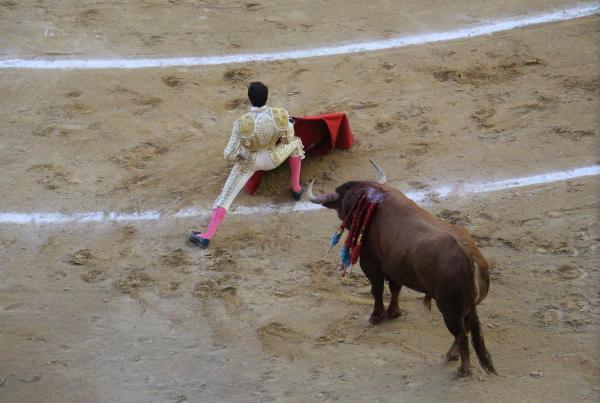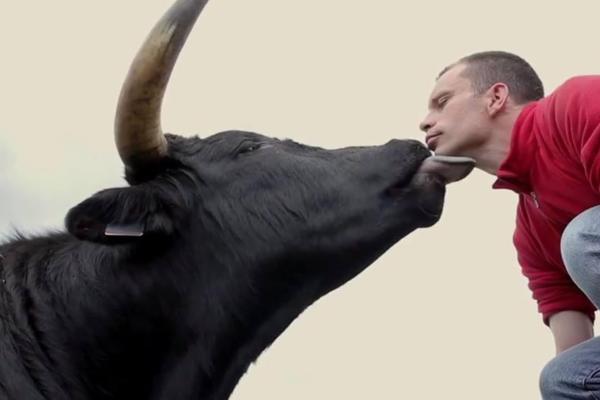
The belief that bulls hate the color red is understandably common, but it is also a myth. Contrary to popular belief, bulls do not specifically target or attack the color red. The misconception that bulls are provoked by the color red likely originates from bullfighting practices in some cultures where the matador waves a red cape or muleta to provoke the bull. However, the red color itself is not the main trigger for the bull's aggression.
At AnimalWised, we explain more about the ‘bulls hate red’ myth. We do so by asking why do bulls attack the color red? We answer this question by looking at how bulls perceive color and how this misconception developed.
Bulls in bullfighting
Bulls are involved in bullfighting primarily as a form of entertainment and cultural tradition in certain regions. Bullfighting has a long history and cultural significance in countries such as Spain, Portugal and parts of Latin America.
The specific reasons for bulls being involved in bullfighting can vary depending on the cultural context. Here are some factors that contribute to their involvement:
- Cultural tradition: bullfighting has been deeply rooted in the cultural heritage of certain regions for centuries. It is often seen as an expression of cultural identity, folklore, and a connection to historical practices.
- Spectator entertainment: bullfighting is considered a form of entertainment for spectators. The event attracts tourists and locals who enjoy the pageantry, skill, and drama associated with bullfighting.
- Skill demonstration: bullfighting is perceived as a demonstration of bravery, artistry, and skill by the matador (bullfighter). It involves precise movements, choreography, and the display of courage in facing a charging bull.
- Economic significance: bullfighting events can contribute to the local economy by attracting tourism, generating revenue from ticket sales, and promoting related industries such as hospitality and tourism services.
It's important to note that bullfighting is a controversial practice, and it has faced significant criticism from animal rights organizations and individuals concerned about animal welfare. Critics argue that bullfighting involves the unnecessary suffering and exploitation of animals.
Find out a little more background on this animal with our article on the difference between an ox and a bull.
Is it true that bulls hate red?
Contrary to popular belief, bulls do not specifically target or attack the color red. The misconception that bulls are provoked by the color red likely originates from bullfighting practices in some cultures where the matador waves a red cape (known as a muleta) to provoke the bull. The red color itself is not the main trigger for the bull's aggression. Here is a detailed explanation of why it seems bulls hate the color red:
Aggression and the bull's nature
Like many other animals, bulls can exhibit aggressive behavior when they feel threatened, provoked or cornered. Bulls are known for their natural instinct to protect their territory, herd or themselves.
Movement and stimuli
Bulls are more reactive to the movement of objects rather than the color. When the matador waves the cape or muleta, it creates visual stimuli in the form of movement, which can stimulate and provoke the bull's attention.
Contrast and visibility
The traditional red color of the cape used in bullfighting is chosen for its visibility and contrast against the arena's background. The red color can make the movements of the cape more apparent to both the bull and the spectators.
Conditioning and training
Bulls involved in bullfighting are often selectively bred and raised for their aggressive traits. They undergo specific training and conditioning to focus on the cape or muleta and respond to the matador's movements, regardless of the color.
Other factors influencing aggression
Besides the movement and stimuli, other factors can contribute to a bull's aggression in a bullfighting context. These include the presence of the crowd, the stress of the environment, the use of weapons and the physical and psychological condition of the bull itself.
It's important to note that bullfighting is a controversial practice. The treatment of bulls in such events has raised ethical concerns. The aggressive behavior of the bulls in bullfighting is artificially heightened through specific training techniques and the use of various stimuli, including the waving of the cape.
In a natural setting, bulls are generally not aggressive toward humans unless they feel threatened or provoked. Like all animals, bulls should be treated with respect and handled appropriately to ensure the safety of both humans and animals involved.
Why do bulls charge at a red cape?
Bulls charging at a cape in the context of bullfighting is a behavior that is a result of specific training and conditioning rather than a natural instinct or response. The charging behavior is a key element of the traditional bullfighting spectacle, where the matador (bullfighter) uses the cape to engage with the bull.
The basic reasons why a bull charges at a red cape are the following:
- Provocation and stimulation
- Movement and visual stimuli
- Conditioning and training
- Reinforcement and reinforcement removal
It's important to note that the charging behavior in bullfighting is artificially heightened and conditioned through specific training techniques and the use of various stimuli. In a natural setting, bulls do not exhibit the same charging behavior towards capes or specific objects.
Learn more about the sport of bullfighting with our article on do bulls feel pain in bullfighting?

How do bulls perceive color?
Like most mammals, bulls have color vision to some extent. They possess a type of color vision known as dichromatic vision, meaning they have two types of color receptors or cones in their eyes. The two types of cones are sensitive to different wavelengths of light, allowing them to perceive certain colors.
The color perception of bulls is similar to that of humans with red-green color blindness, where they have difficulty distinguishing between certain shades of red and green. Bulls primarily have receptors for blue and green wavelengths of light, which means they can perceive shades of blue and green more accurately than they can perceive shades of red and green.
It's important to note that bulls do not have the same visual acuity as humans. Their vision is adapted to detect movement and notice contrasts rather than fine details. They have a wider field of view, reaching nearly 360 degrees, with a slight blind spot directly behind them.
When it comes to the color red, bulls do not have a particular aversion or attraction to it based solely on its color. The misconception that bulls react aggressively to the color red is likely a result of cultural practices in bullfighting, as mentioned earlier, where the waving of a red cape is used to provoke and stimulate the bull's attention through movement, not color.
In conclusion, bulls have dichromatic color vision, and while they can perceive certain colors, their visual acuity and color discrimination are not as precise as that of humans. Bulls primarily rely on movement, contrasts, and other visual cues to navigate their environment and respond to stimuli.
If you want to read similar articles to Why Do Bulls Attack the Color Red?, we recommend you visit our Facts about the animal kingdom category.